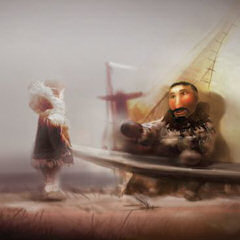
Followers of this blog caught the first half of the traditional Iñupiaq story, “Kunuuksaayuka,” last week; the tale of Kunuuksaayuka is one of the major influences on the narrative of Never Alone. In addition to presenting the final half this week, we’d like to briefly profile the master storyteller who committed this and many other Iñupiaq stories to record so that they could be shared with future generations.
Robert Nasruk Cleveland was born near the end of the 19th century and was one of the most prolific and powerful storytellers in Iñupiat history.
Mr. Cleveland spent most of his life living along the Black River in Alaska where he was skilled in the art of subsisting off the land.
During his youth (the late 1800s and early 1900s), Robert spent countless hours in the qargi; it was in these community houses with Elders that he began to learn classic Iñupiaq stories and develop the storytelling skills that distinguished him as one of the leading masters of the oral storytelling tradition. Mr. Cleveland spent a significant part of his early life with the Elders committing his people’s history to memory.
Mr. Cleveland began sharing pieces of the Iñupiaq culture in collections such as Stories of the Black River People, but he made sure to commit the entire breadth of his knowledge to reel-to-reel tape recordings before he passed away, ensuring that future generations of Iñupiat people would have access to their history.
(Continued from Part One)
He briefly looked at the strange sight, retraced his steps and started to approach the man from behind. The man back there was working so hard that he wasn’t even aware of any approaching strangers. Apparently he worked this hard all day long with no thought of caution.
Kunuuksaayuka went toward the man, walking closer each time the shoveled snow swirled with the wind. Every time it calmed down, Kunuuksaayuka hid so that the man wouldn’t see him. This was the manner in which he crept up close behind him.
He had come close enough so that the next time there was a blizzard, he would have been able to reach the man when the man started to mash the snow again. It is said that he was a big man. After he had mashed the snow, he grabbed his shovel and as he began to shovel the snow quickly into the air, Kunuuksaayuka ran towards the adze the man had used to mash the snow and grabbed it! Away Kunuuksaayuka went with the adze as the big man shoveled the snow, creating blizzard after blizzard.
However the big man saw him as Kunuuksaayuka grabbed the adze. He threw down his shovel, climbed up from the flat tundra and ran after Kunuuksaayuka, but Kunuuksaayuka was too fast. Off he had run with the adze in his hand. The big man chased him without catching him, until Kunuuksaayuka had successfully entered his home with the adze.
Once inside, Kunuuksaayuka lay down on his bed. It is said that he was situated across from his mother. Kunuuksaayuka hadn’t lain down long when he heard someone climbing on top of their house to the skylight. Having climbed up to the skylight, the big man could be heard to sing about Kunuuksaayuka. This is how it went:
Kunuuksaayukamun Atuun
Ku-nuuk-saa-ya-kaa haa ŋia ŋia
Ulimantiga qail li hia ia ia
Uvlaakullia ŋia aniyuvich
Isigaak kisimiaia qiñiqpatiin
English equivalent
Ku-nuuk-saa-ya-kaa haa ŋia ŋia
Give me my adze hia ia
So that tomorrow when you go outside
you will find caribou feet
It is said that the big man sang this song over and over again outside of the skylight. He wanted Kunuuksaayuka to return the adze that he had brought inside the house.
This happened until after listening to him sing all day, Kunuuksaayuka’s mother finally grew tired of him and said to her son, “What oh what did you get that the one up there wants anyway?” Although she asked him this, Kunuuksaayuka did not answer and only ignored her.
After that, he lay still for a while until he finally stood up. He then grabbed the adze and began to use it against the stones that surrounded the fireplace. It is said that by hitting the rocks with it, he ruined the edge of the blade. This done, he then threw it out of the skylight.
The big man had seen his adze being tossed up and out the skylight and because this made him so happy, he burst out laughing like this:
Kunuuksaayuka aŋa ha, iŋi hi.
After this loud laugh, he was quiet for a while when he was again heard to sing from above. Once again he sang:
Ku-nuuk-saa-ya-kaa haa ŋia ia
Who chipped the blade of my adze ŋia ia
So that tomorrow when you go outside
You will see caribou feet.
It is said that he sang the same song, except that he used kikivauŋ instead of qaiḷḷi, meaning that he changed the words to ‘chip the blade’ instead of ‘give me back.’ It is also said that after singing this song, he left and could no longer be heard.

 Subscribe via RSS
Subscribe via RSS






